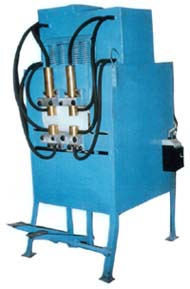Electric contact heating of metal parts
Electric contact heating — purpose, device, principle of operation
Applications of electric contact heating
Direct heating devices are usually called those in which the transformation of electrical energy into thermal energy occurs in a heated material or product when they are directly connected to a power source due to the passage of an electric current through them according to Joule's law — Lenz. Direct heating is effective for heat treatment of products with a uniform cross-section along the length and a significant ohmic resistance. Direct heating has no limits on achievable temperatures, has a high speed proportional to the input power, and high efficiency.
Contact heaters are designed for simple parts (shafts, axles, strips), heating billets for forging, tubes for annealing, wire, spring wire for winding. There are batch type direct heating furnaces for sintering rods and bars of rare and refractory powders.metals at temperatures up to 3000 K in a protective atmosphere. The part (part) is included in an electrical circuit and is heated by an electric current flowing through it. Because the resistance of the circuit is small, then a high current is needed for heating, which led to it with the help of massive copper or bronze clamps. (Contacts).
 It can be heated with direct or alternating current, but practically it is applied only alternating current, since the required currents for heating are hundreds and thousands of amperes at voltages from tenths of a volt to 24 V can be at most simply obtained only with AC transformers. Difficulty supplying current to the part is one of the significant disadvantages of contact heating parts. The clamps must have good contact with the workpiece. In the industrial, in direct heating installations, pneumatic and hydraulic drives are used for this, to lower the temperature in the contacts, making them water-cooled.
It can be heated with direct or alternating current, but practically it is applied only alternating current, since the required currents for heating are hundreds and thousands of amperes at voltages from tenths of a volt to 24 V can be at most simply obtained only with AC transformers. Difficulty supplying current to the part is one of the significant disadvantages of contact heating parts. The clamps must have good contact with the workpiece. In the industrial, in direct heating installations, pneumatic and hydraulic drives are used for this, to lower the temperature in the contacts, making them water-cooled.
The direct heating installation includes the following main components:
a) step-down transformer installed in the body of an installation with a water-cooled winding and several voltage steps in the range 5–25 V, providing heating of bodies of different resistances;
b) the current line from the low voltage winding terminals of the transformer to the water-cooled clamps;
c) clamps that provide fastening of the heated product and the necessary pressure in the contacts of the power supply;
d) drive the contact system;
e) devices for monitoring and automatic regulation of the heating process.
In continuous heating installations, pipes, rods, solid rolls or liquid contacts are used.
Furnaces with direct heating are also used for graphitizing coal products, for the production of carborundum, etc. Graphite furnaces are single-phase, rectangular with split walls. They reach a temperature of 2600–3100 K in a vacuum or neutral atmosphere. Secondary voltage regulation range 100–250 V, power consumption 5–15 thousand kV × A.
